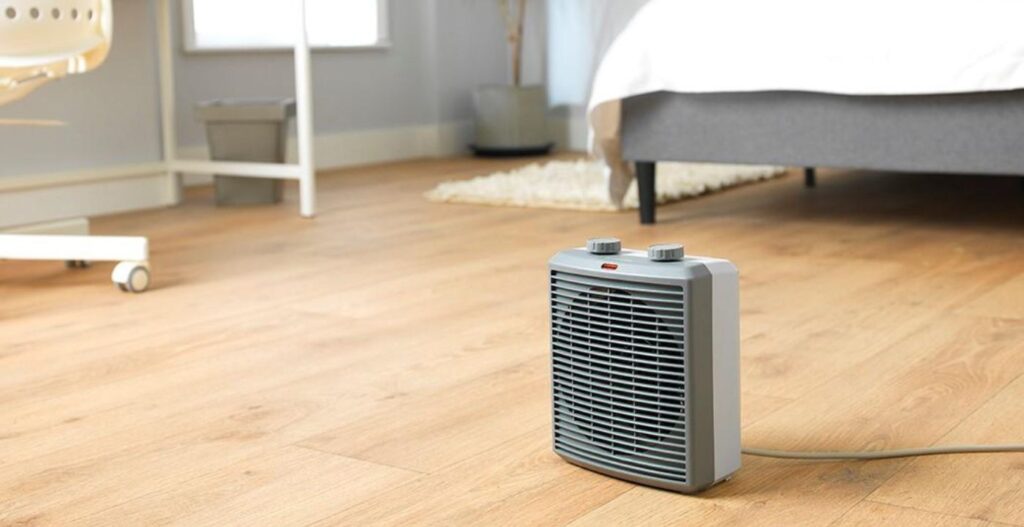Key Takeaways
- Ceramic heaters are convection heaters that function by heating up the air in the room. This is inherently less efficient than radiant heaters due to the heat lost in this process.
- By contrast infrared heaters are 100% energy efficient, providing direct, focused heat, with no loss of energy.
- Ceramic heaters take significantly longer to reach their target temperature, making them less efficient than infrared heaters that offer nearly instant heat.
What is a Ceramic Heater?

Ceramic heaters are a type of convection heater. They function by heating up a ceramic element, which then heats up the air around it. This warm air rises and circulates around the room, gradually raising the room temperature.
There are two main variations of ceramic heaters:
- Regular models without fans
- Fan-aided models, which are recommended for larger rooms due to their ability to distribute heat more evenly.
What is an Infrared Heater?

Infrared heaters work on a different principle. They emit infrared radiation that directly heats objects and people in its path. Instead of warming the air, they provide direct, focused heat. This means they can provide warmth faster, especially in a direct line of sight.
Common types include:
- Wall-mounted or ceiling-mounted panels that are fixed to a particular spot.
- Stand-alone and Stand-and-swivel models that can be directed towards specific areas.
The Advantages of Ceramic Heaters
- Safety: The ceramic element in these heaters doesn’t get as hot as other types of heating elements, reducing the risk of fires.
- Even Heating: They provide uniform heat throughout the room, ensuring no cold spots.
- Portability: Ceramic heaters are often lightweight and easy to move around, enabling you to heat multiple rooms successively.
- Safety: Many models come with overheating protection and protection grills, safeguarding your home, children, and pets.
- Powerful: Despite their compact nature, most good quality panels can effectively heat large spaces.
The Disadvantages of Ceramic Heaters
- Slower Warm-Up: They can take a little longer to warm up a room compared to radiant heaters.
- Noise: Some models can be a bit noisy due to the fan used to circulate the warm air.
- Not Primary Sources: They are best used as supplemental heat sources rather than the primary method of warming a home.
- Limited Temperature Settings: Many models offer limited temperature settings, restricting precise temperature control.
- High Operating Costs: Due to their lower efficiency extended use can significantly raise electricity bills.
The Advantages of Radiant Heaters
- Instant Heat: They provide immediate warmth, making them perfect for spot heating.
- 100% Energy Efficient: All the power consumed is converted into heat.
- Silent Operation: These heaters operate silently as they don’t rely on fans.
- Less Dust Circulation: Without a fan, they are less likely to circulate dust around the room.
- Space Efficiency: Due to their compact design or wall-mounting feature, they save floor space.
- Clean Heating: These heaters do not produce smoke, ash, or dust, making them ideal for those with allergies.
- Technologically Advanced: Some models come with smart features, including WiFi connectivity, allowing for remote control via smartphones.
The Disadvantages of Radiant Heaters
- Higher Upfront Cost: A good quality radiant heater is likely to have a higher upfront cost than alternatives like ceramic heaters or electric radiators.
- Slower Room Heating: While they provide instant warmth to objects, they may not heat an entire room as quickly as ceramic heaters.
Radiant vs Ceramic Heaters

Efficiency
Efficiency in heating refers to the capacity of an appliance to convert energy to warmth.
Using the analogy of pouring water from a jar into a glass, if all the water is transferred without any spillage, that’s 100% efficient. Similarly, with heaters, you want minimal energy wasted.
Infrared (radiant) vs. Ceramic
Both ceramic and infrared heaters utilize electricity. However, the manner in which they deliver heat varies.
Radiant heaters use infrared waves targeting objects and individuals directly, ensuring that practically all energy consumed is used for heating, giving them a near 100% efficiency.
Ceramic heaters, on the other hand, employ a ceramic heating element and a fan to distribute warmth, which may not be as efficient as direct infrared heating.
If you’re in a region with high electricity costs, the energy-efficient nature of infrared heaters might be more appealing.
Price & Associated Costs
Initial Investment
Infrared heaters, given their technology, might seem pricier.
While basic infrared models can start at around $150, ceramic heaters can be found for as low as $90-$100.
However, high-end models for both types can reach upwards of $1500.
Hidden Costs
It’s crucial to consider not just the initial price but also ongoing expenses.
Infrared heaters, devoid of moving parts, often incur fewer repair costs.
Ceramic heaters, with their multiple components, might require more frequent maintenance and repairs, potentially leading to higher costs over time.
Running Costs
While both heaters need electricity, their consumption rates vary, often significantly.
Infrared heaters, being nearly 100% efficient and having no moving parts, direct all of the consumed power to generate heat.
Ceramic heaters, in contrast, need power for both the heating element and the fan, and only provide heat indirectly, increasing energy consumption and potentially raising electricity bills.
Lifespan & Maintenance
Durability Insights
Infrared heaters generally have a longer lifespan, with certain quartz-based models lasting up to 60,000 hours or longer.
Ceramic heaters, although designed to last a few years, might have a reduced lifespan if not well-maintained.
Maintenance Matters
A significant difference lies in their components. Infrared heaters lack moving parts, requiring minimal maintenance.
In contrast, ceramic heaters come with fans and other movable components, which can wear out or malfunction, necessitating regular checks and potential replacements, particularly over the long-term.
FAQs
Is a ceramic heater better than a radiator?
While both serve the purpose of heating, ceramic heaters offer quick warmth and are portable, making them suitable for instant heating needs.
Radiators, on the other hand, provide consistent heating over longer durations and will likely be cheaper to use for whole room heating.
Are ceramic heaters radiant heaters?
No. While both heaters produce warmth, ceramic heaters heat the air surrounding their ceramic plates, whereas radiant heaters produce infrared radiation, directly warming objects and individuals.
Are ceramic heaters more efficient?
Efficiency varies based on the application. For quick heating in smaller spaces, ceramic heaters might be more efficient.
However, for sustained heating in standard-sized rooms, infrared radiant heaters might prove more energy-efficient.
Conclusion
Choosing between ceramic and infrared heaters largely depends on individual needs and preferences.
If you prioritize efficiency and long-term savings, suffer from allergies, or desire a more comfortable warmth in your home, infrared might be your best choice.
On the other hand, if you’re looking for instant heating and are on a tight budget (in regard to the initial purchase cost), a ceramic heater might be more apt.





